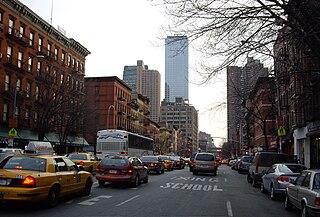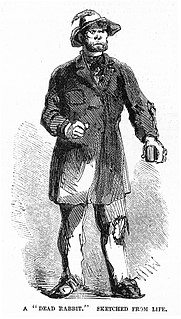| Founded | c. 1890 |
|---|---|
| Founding location | Hell's Kitchen, New York |
| Years active | 1890s–1910s |
| Territory | Manhattan |
| Ethnicity | Irish-American |
| Membership (est.) | ? |
| Criminal activities | Burglary, armed robbery, street muggings, assault, strikebreaking. |
| Allies | Gopher Gang |
| Rivals | Parlor Mob The Gorillas |
The Rhodes Gang was an American street gang based in New York City at the turn of the 20th century. The group was one of several smaller Hell's Kitchen gangs affiliated with the Gopher Gang, all of whom were almost constantly fighting among each other, among these including The Gorillas and the Parlor Mob. [1] [2] They were known, at times, to briefly put aside their differences when police attempted to interfere in gang fights [3] and authorities found the area impossible to control. [4]

The City of New York, usually called either New York City (NYC) or simply New York (NY), is the most populous city in the United States. With an estimated 2018 population of 8,398,748 distributed over a land area of about 302.6 square miles (784 km2), New York is also the most densely populated major city in the United States. Located at the southern tip of the state of New York, the city is the center of the New York metropolitan area, the largest metropolitan area in the world by urban landmass and one of the world's most populous megacities, with an estimated 20,320,876 people in its 2017 Metropolitan Statistical Area and 23,876,155 residents in its Combined Statistical Area. A global power city, New York City has been described as the cultural, financial, and media capital of the world, and exerts a significant impact upon commerce, entertainment, research, technology, education, politics, tourism, art, fashion, and sports. The city's fast pace has inspired the term New York minute. Home to the headquarters of the United Nations, New York is an important center for international diplomacy.

Hell's Kitchen, sometimes known as Clinton, is a neighborhood on the West Side of Midtown Manhattan in New York City. It is traditionally considered to be bordered by 34th Street to the south, 59th Street to the north, Eighth Avenue to the east, and the Hudson River to the west. The area provides transport, medical, and warehouse-infrastructure support to Midtown's business district.

The Gopher Gang was an early 20th-century New York street gang known for its members including Goo Goo Knox, James "Biff" Ellison, and Owney Madden. Based in the Irish neighborhood of Hell's Kitchen, the Gopher Gang grew to control most of Manhattan with their territory covering Fourth to Forty-Second Street and Seventh to Eleventh Avenue.
The membership of the Rhodes Gang, like many other rival gangs, quickly dropped following the breakup of the Gophers by railroad detectives of the New York Central Railroad in 1910. The New York Police Department soon began efforts to rid the city of the remaining street gangs and, by 1916, the Rhodes Gang and the other Manhattan-based gangs had disbanded permanently. [5]

The New York Central Railroad was a railroad primarily operating in the Great Lakes region of the United States. The railroad primarily connected greater New York and Boston in the east with Chicago and St. Louis in the Midwest along with the intermediate cities of Albany, Buffalo, Cleveland, Cincinnati, and Detroit. New York Central was headquartered in New York City's New York Central Building, adjacent to its largest station, Grand Central Terminal.

Manhattan, often referred to locally as the City, is the most densely populated of the five boroughs of New York City and its economic and administrative center, cultural identifier, and historical birthplace. The borough is coextensive with New York County, one of the original counties of the U.S. state of New York. The borough consists mostly of Manhattan Island, bounded by the Hudson, East, and Harlem rivers; several small adjacent islands; and Marble Hill, a small neighborhood now on the U.S. mainland, physically connected to the Bronx and separated from the rest of Manhattan by the Harlem River. Manhattan Island is divided into three informally bounded components, each aligned with the borough's long axis: Lower, Midtown, and Upper Manhattan.
The gang was referenced in the historical novels A Long Line of Dead Men: A Matthew Scudder Mystery (1999) by Lawrence Block and Michael Walsh's And All the Saints: A Novel (2003).
Lawrence Block is an American crime writer best known for two long-running New York–set series about the recovering alcoholic P.I. Matthew Scudder and the gentleman burglar Bernie Rhodenbarr. Block was named a Grand Master by the Mystery Writers of America in 1994.
Michael A. Walsh is an American music critic, author, screenwriter, media critic, and cultural-political consultant.


